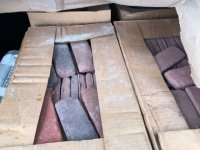Professionally installed screw piles can work well but at almost an order of magnitude more, there arent many situations that justify it.Got a quote from Techno Metal Post for a shed. Six 7' piles installed with saddles. $3689 all in! Lol.
Sono tubes and concrete it is then.
You are using an out of date browser. It may not display this or other websites correctly.
You should upgrade or use an alternative browser.
You should upgrade or use an alternative browser.
Enough of COVID...what are you doing to the house?
- Thread starter mimico_polak
- Start date
I can't use screw piles or dig much with a post hole digger here. The only real option is to dig the hole with a backhoe or excavator and install sona tube. Ground is full of watermelon and bigger size rocks.
Sent from the future
Sent from the future
AllistonGT
Well-known member
Now I'm looking at Pylex. What are the, if any, concerns using these?
Good thing you got that swanky blue excavator!I can't use screw piles or dig much with a post hole digger here. The only real option is to dig the hole with a backhoe or excavator and install sona tube. Ground is full of watermelon and bigger size rocks.
Sent from the future
Not gonna lie…I want an excavator for no reason. Just want it. I’ll find a use for it.
Mad Mike
Well-known member
Why not use Pylex? $50 each, stupid-simple to install. The $3689 crowd dismisses them for obvious reasons.Got a quote from Techno Metal Post for a shed. Six 7' piles installed with saddles. $3689 all in! Lol.
Sono tubes and concrete it is then.
I did a 24x8 front porch using 4 piles, been rock solid for 4 years.
AllistonGT
Well-known member
Looking into them now. Concept is definitely appealing. Noticed load just sits on top. No way of anchoring?Why not use Pylex? $50 each, stupid-simple to install. The $3689 crowd dismisses them for obvious reasons.
I did a 24x8 front porch using 4 piles, been rock solid for 4 years.
Because they are very misleading in their specs? When I looked before, they provided load rating per pile that was completely bonkers. Maybe if they were installed to contact bedrock but you wouldnt use screw piles in that case. Realistic load rating was more than an order of magnitude lower than advertised number which means you need an order of magnitude more piles. Ultimately you are relying on the screw that is ~4-6" diameter to provide all load carrying. Installation loosened up all soil around the shaft so the pile will have trouble transferring any load from shaft to soil.Why not use Pylex? $50 each, stupid-simple to install. The $3689 crowd dismisses them for obvious reasons.
I did a 24x8 front porch using 4 piles, been rock solid for 4 years.
AllistonGT
Well-known member
They spec 3500 - 5000lbs/pier. 6 piers. Whats a shed going to weigh? 2000lbs? Not sure the weight is of concern. I'm still on the fence.Because they are very misleading in their specs? When I looked before, they provided load rating per pile that was completely bonkers. Maybe if they were installed to contact bedrock but you wouldnt use screw piles in that case. Realistic load rating was more than an order of magnitude lower than advertised number which means you need an order of magnitude more piles. Ultimately you are relying on the screw that is ~4-6" diameter to provide all load carrying. Installation loosened up all soil around the shaft so the pile will have trouble transferring any load from shaft to soil.
I think real load rating is more on the order of 300 lbs per pile. Their math doesnt add up. Why is a 12" sonotube good for 1600 lbs and a 6" pile good for 5000 with a quarter of the area? What kind of magic soil is below the screw pile?They spec 3500 - 5000lbs/pier. 6 piers. Whats a shed going to weigh? 2000lbs? Not sure the weight is of concern. I'm still on the fence.
AllistonGT
Well-known member
Perhaps it's the new math?I think real load rating is more on the order of 300 lbs per pile. Their math doesnt add up. Why is a 12" sonotube good for 1600 lbs and a 6" pile good for 5000 with a quarter of the area? What kind of magic soil is below the screw pile?
As noted I have used the Pylex screw piles with great success. Soil here is sandy but we have massive trees (and roots), seems to cut through the roots.
The tricky parts, getting them in straight doing it by yourself. I did not drive in a rod first like they recommend that may help guide it. They are REALLY hard to drive in the last couple of feet, 8+ foot 2X4 for leverage which becomes a problem if close to a structure or worse yet in a corner.
This summer I have two more to drive in if I expand my shed to the new rules. The generous guy I am, I will let anyone from GTAM to come over and help me drive them in to see how you like it....
The tricky parts, getting them in straight doing it by yourself. I did not drive in a rod first like they recommend that may help guide it. They are REALLY hard to drive in the last couple of feet, 8+ foot 2X4 for leverage which becomes a problem if close to a structure or worse yet in a corner.
This summer I have two more to drive in if I expand my shed to the new rules. The generous guy I am, I will let anyone from GTAM to come over and help me drive them in to see how you like it....
AllistonGT
Well-known member
I just sent Pylex an email asking them to explain.I think real load rating is more on the order of 300 lbs per pile. Their math doesnt add up. Why is a 12" sonotube good for 1600 lbs and a 6" pile good for 5000 with a quarter of the area? What kind of magic soil is below the screw pile?
If they don't respond I will have my answer.
I didn’t know these things existed and since I’m getting ready to build a kids playhouse they’re much more appealing than doing cement around the posts.
DownUnder
Well-known member
Hire one of these to do it...As noted I have used the Pylex screw piles with great success. Soil here is sandy but we have massive trees (and roots), seems to cut through the roots.
The tricky parts, getting them in straight doing it by yourself. I did not drive in a rod first like they recommend that may help guide it. They are REALLY hard to drive in the last couple of feet, 8+ foot 2X4 for leverage which becomes a problem if close to a structure or worse yet in a corner.
This summer I have two more to drive in if I expand my shed to the new rules. The generous guy I am, I will let anyone from GTAM to come over and help me drive them in to see how you like it....
AllistonGT
Well-known member
Pylex responded to my inquiry. They sent me the engineers stamped documents. Total 54 pages worth. The way I read it (I work with wood products not engineer documents) it looks legit and satisfies building code.
If any one wants a copy, PM me your email and I'll send them.
If any one wants a copy, PM me your email and I'll send them.
Have some fun...ask to speak to the engineer. See if he/she still works there.Pylex responded to my inquiry. They sent me the engineers stamped documents. Total 54 pages worth. The way I read it (I work with wood products not engineer documents) it looks legit and satisfies building code.
If any one wants a copy, PM me your email and I'll send them.
AllistonGT
Well-known member
Outside firm. I'm not making this my life's crusade.Have some fun...ask to speak to the engineer. See if he/she still works there.
Thanks for sending. I looked through it. This isn't an official review (as I am entirely unqualified) just the things I noticed that stood out.Pylex responded to my inquiry. They sent me the engineers stamped documents. Total 54 pages worth. The way I read it (I work with wood products not engineer documents) it looks legit and satisfies building code.
If any one wants a copy, PM me your email and I'll send them.
Prepared by a structural engineer working for a structural engineering company.
No lateral capacity. If lateral forces exist, a lateral restraint must be used. I suspect nobody does this.
They do not rely on soil/shaft friction for capacity (good because there wouldn't be much).
Pile capacity is closely related to soil composition/compaction. You must know the makeup prior to installing piles. I suspect nobody does this. The whole point of screw piles is fast and minimally invasive, you aren't digging a pit to look and you sure as hell aren't getting a geotech report.
Standard height of 50" with 1.875" pitch. So about 25 full rotations to install.
6" diameter plate.
Some strange remarks that are probably related to engineer being ESL (eg. Electrical soldering on a drawing).
I think most of my confusion comes from rule of thumb calcs for bearing capacity of poured concrete cylindrical footings. The normal numbers are 2000 psf for sand and 1500 psf for clay. How do the screw piles which rely only on bearing capacity of the helix use a bearing capacity well above 8000 psf? Answer is above my pay grade.
Last edited:
I am shocked they are loose bricks. I was expecting sheets to speed things up.The bricks came in today….700lbs of worth of thin bricks, mesh, grout and glue.
View attachment 60352
View attachment 60353



















